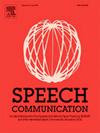"I said simPle, not symBol!"Is clear speech tailored to the listener's feedback
IF 3
3区 计算机科学
Q2 ACOUSTICS
引用次数: 0
Abstract
This study investigates variation in the production of French stop consonants in two situations of speech clarity enhancement – when addressing an interlocutor experiencing listening difficulties in a disrupted communication environment (clear speech), and when correcting specific listener misunderstandings (corrected speech). Of interest is whether speech modifications are similar in both situations, or if adjustments during correction specifically address listeners' errors.
Twelve native French speakers interacted with the experimenter in a gaming task, first in conversational speech ('Conv') under normal conditions, then in clear speech prompted by apparent listening difficulties from the interlocutor ('Clear'). In the disrupted situation, some words were misunderstood by the listener (errors in either voicing or articulation place of stop consonants), resulting in additional corrections by the speaker ('Clear+Corr').
Significant changes in the timing and spectral cues of stop consonants (closure duration, Voice Onset Time, burst spectrum) were observed in both clear and corrected speech, improving distinctions between voiced and voiceless stops and articulation places. Additionally, clear speech prompted by listening difficulties showed global modifications (overall increased intensity, longer syllable duration, hyper-articulated vowels). Conversely, corrected speech focused solely on segmental modifications, with burst spectrum variations significantly influenced by listener feedback, emphasizing the distinction between the speaker's intended segment and the misunderstood one.
The results suggest that both situations of speech clarity enhancement involve different strategies, with speech correction relying on real-time perception of the listener's feedback to specifically address perceptual errors.
“我说的是简单,不是符号!”清晰的演讲是根据听众的反馈量身定制的吗
本研究调查了两种语音清晰度增强情况下法语顿音产生的变化-在中断的沟通环境中解决对话者听力困难时(清晰的语音),以及纠正特定的听者误解时(纠正的语音)。令人感兴趣的是,在这两种情况下,语音修改是否相似,或者在纠正过程中是否专门针对听者的错误进行调整。12名母语为法语的人在游戏任务中与实验者互动,首先在正常条件下进行对话式演讲(“Conv”),然后在对话者明显听力困难的情况下进行清晰的演讲(“clear”)。在中断的情况下,一些单词被听者误解(发音或停止辅音的发音位置错误),导致说话者额外纠正(“Clear+Corr”)。在清晰和纠正后的语音中,停辅音的时间和频谱线索(关闭时间、发声时间、爆发频谱)都发生了显著变化,提高了浊音和不浊音的停顿和发音位置的区别。此外,听力困难导致的清晰言语表现出整体的变化(整体强度增加,音节持续时间延长,元音发音过度)。相反,纠正后的语音只关注片段修改,突发频谱变化受听者反馈的显著影响,强调了说话者预期的片段和误解的片段之间的区别。结果表明,两种情况下的语音清晰度增强涉及不同的策略,语音纠正依赖于听众反馈的实时感知,以具体解决感知错误。
本文章由计算机程序翻译,如有差异,请以英文原文为准。
求助全文
约1分钟内获得全文
求助全文
来源期刊

Speech Communication
工程技术-计算机:跨学科应用
CiteScore
6.80
自引率
6.20%
发文量
94
审稿时长
19.2 weeks
期刊介绍:
Speech Communication is an interdisciplinary journal whose primary objective is to fulfil the need for the rapid dissemination and thorough discussion of basic and applied research results.
The journal''s primary objectives are:
• to present a forum for the advancement of human and human-machine speech communication science;
• to stimulate cross-fertilization between different fields of this domain;
• to contribute towards the rapid and wide diffusion of scientifically sound contributions in this domain.
 求助内容:
求助内容: 应助结果提醒方式:
应助结果提醒方式:


